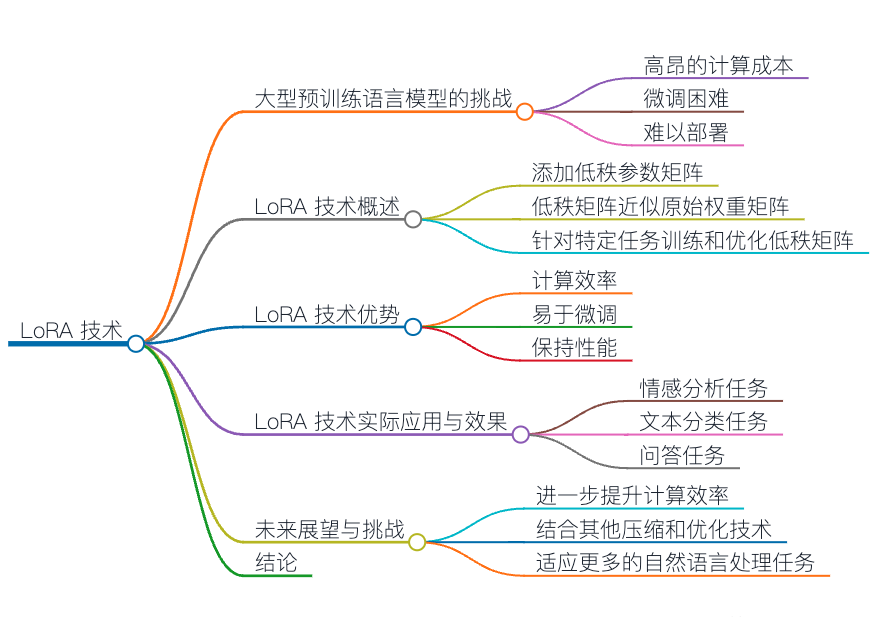With the rapid development of deep learning, large pre-trained language models (such as GPT-3, BERT, etc.) have achieved remarkable success in various natural language processing tasks. However, these models often have a large number of parameters, making it very difficult to run and fine-tune with limited computational resources. To solve this problem, the researchers proposed an optimization technique called LoR a (Low-Rank Adaptation of Large Language Models, a low-rank adaptation for large language models). This paper will introduce LoR a technology in detail, analyze its application and advantages in large-scale language models, and demonstrate the effectiveness of LoR a through examples.

1. . Challenges for large pre-trained language models
Large pre-trained language models have achieved remarkable results in natural language processing tasks, but the computational costs and resource requirements brought about by these models are also increasingly prominent. The specific performance is in the following aspects:
1. High computing cost: Large pre-trained language models usually have billions or even tens of billions of parameters, which makes the model need to consume a lot of computing resources in the process of training and reasoning, which is an unbearable burden for many users and enterprises.
2. Fine-tuning difficulties: Fine-tuning large pre-trained language models on specific tasks requires a lot of computational resources and time. This limits the popularity of these models in practical application scenarios.
3. Difficult to deploy: Due to the large number of parameters, large pre-trained language models face great challenges to deploy and operate on edge devices and mobile devices.
Therefore, how to reduce the computational cost and resource requirements of large pre-trained language models while maintaining performance has become an important topic of current research.
2. LoRa Technical overview
LoRa (Low-Rank Adaptation of Large Language Models, low-rank adaptation of large language models) is an optimization technique for large pre-trained language models. The core idea is to use low-rank approximation techniques to adapt and fine-tune large pre-trained language models to reduce the computational cost of the model on a specific task, while maintaining high performance.
The implementation process of LoRa mainly includes the following steps:
1. Add a low-rank parameter matrix to the output layer of the original model: This low-rank matrix can fine-tune the original model to meet the needs of a specific task.
2. Approximate the weight matrix in the original model by the low-rank matrix: this can reduce the number of model parameters, reduce the computational complexity, and maintain high performance.
3. Train and optimize the low-rank matrix based on the task-specific data set: to ensure the performance of the model on the new task.
3. LoRa Advantages of the technology
The application of LoR a technology in a large pre-trained language model has the following significant advantages:
1 Computational efficiency
By reducing the number of model parameters, LoRa can significantly reduce the computational cost of the model on a particular task. This enables a more efficient operation of large pre-trained language models with limited computational resources. This advantage is particularly important for deploying models on edge devices and mobile devices.
2 Easy to fine-tune
LoRa By adding a low-rank matrix to the output layer, the model can be fine-tuned to specific tasks. This allows the model to adapt faster to the new task without the expensive retraining of the entire model. This advantage contributes to the popularization of large pre-trained language models in practical application scenarios.
3 Maintain performance
Despite the reduced computational complexity using the low-rank approximation, LoR a is generally able to maintain performance close to the original model. This means that on a specific task, LoR a can achieve improved computational efficiency without loss of performance.
四、 LoRa Practical application and effect of the technology
To verify the effectiveness of LoRa technology in large pre-trained language models, the researchers conducted experiments on multiple natural language processing tasks. Here are some typical experimental results:
1, in the sentiment analysis task, the model using LoRa technology had comparable performance to the original model, but the computational cost was reduced by about 70%.
2. In the text classification task, LoRa technology reduces the computing cost by about 60% without losing performance.
3. In the question and answer task, LoRa technology achieved similar performance to the original model, while reducing the computational cost by about 50%.
These experimental results show that the LoRa technique has significant advantages in large pre-trained language models to reduce the computational cost and resource requirements while maintaining performance. This makes LoRa ideal for running large pre-trained language models with limited computational resources.
5. Future prospects and challenges
Although the application of LoR a technology in large pre-training language models has achieved some results, there are still some challenges and future development possibilities:
1. Further improve the computational efficiency
Although LoR a technology has reduced computing costs to some extent, there is still a need to further optimize and improve computing efficiency for certain specific scenarios and devices (such as edge computing devices, Internet of Things devices, etc.).
2. Combine other compression and optimization techniques
LoRa The technology can be combined with other model compression and optimization techniques (such as knowledge distillation, network pruning, etc.) to further improve the performance and computational efficiency of large pre-trained language models on specific tasks.
3. Adapt to more natural language processing tasks
At present, LoR a technology has achieved remarkable results in some natural language processing tasks. However, it is still necessary and necessary to optimize the effectiveness and applicability of LoR a technology in more tasks and scenarios to drive its wide application in practical applications.
Six, the conclusion
LoRa (Low-Rank Adaptation of Large Language Models, Low-rank Adaptation of Large Language models) is an optimization technique for large pre-trained language models, which reduces the computational cost of the model on a specific task by using the low-rank approximation, while maintaining high performance. Experiments show that LoR a technology has significant advantages in multiple natural language processing tasks, and can realize the efficient operation of large-scale pre-trained language models with limited computing resources. In the future, LoR a technology needs to be further studied and developed in improving computational efficiency, combining other compression technologies and adapting to more tasks.
Contact: Qui
Phone: 18146178586
Tel: 18146178586
Email: qui@zonewu.com
Add: 1501-3, Building F03, Phase III, Software Park, Jimei District, Xiamen City, Fujian Province, China
